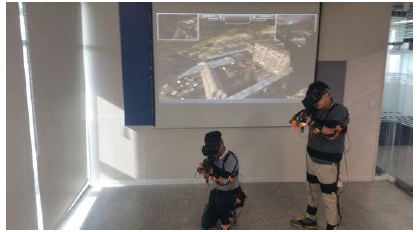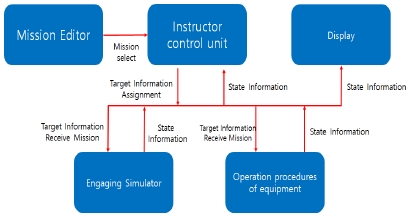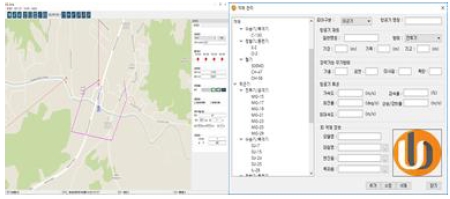
Design of Immersive Experience Training System with Virtual Reality Technology (VR)
Copyright ⓒ 2018 The Digital Contents Society
This is an Open Access article distributed under the terms of the Creative Commons Attribution Non-CommercialLicense(http://creativecommons.org/licenses/by-nc/3.0/) which permits unrestricted non-commercial use, distribution, and reproduction in any medium, provided the original work is properly cited.

Abstract
With the 4th Industrial Revolution, the battlefield environment has shifted to network-oriented, and the need for M & S (Modeling & Simulation) is increasing day by day. In the current environment where the development costs of the advanced weapon system and the training cost increase rapidly and the complexity of design, test evaluation and production increases, M & S can effectively reduce time and cost by reducing the risk of development failure have. However, in the case of training contents using M & S, the sense of user immersion is low. In this paper, we propose a training system using virtual reality technology which can maximize immersion through interaction and complement the limitations of existing training methods. The designed training system is designed with mission editor, instructor control system, situation display, simulation of the fighting and experience of the equipment operation procedure. More intensive training than existing M & S is possible.
초록
4차 산업 혁명으로 인하여 전장 환경이 네트워크 중심으로 변화함에 따라 M&S의 필요성이 나날이 증가하고 있다. M&S는 첨단 무기체계 개발 비용 및 훈련비용이 급격히 상승하고 설계, 시험평가 및 제작의 복잡성이 증가한 현 환경에서 M&S 기법을 적용하면 시간과 비용을 효과적으로 단축시킬 수 있어 개발 실패 위험(Risk)을 줄일 수 있다. 그러나 M&S를 활용한 교육 훈련 콘텐츠의 경우 사용자 몰입감이 낮으며, 사수 중심의 훈련 지원으로 협동 훈련 등이 제한된다. 본 논문에서는 훈련 시작부터 평가까지 한 번에 모두 관리가 가능한 Life Cycle 방식과 가상현실 기술을 적용한 훈련시스템 설계를 제안 한다. 설계한 훈련시스템은 임무 편집기, 교관 통제기, 상황전시기, 교전 모의기, 장비의 운용 절차 체험기로 설계되었으며, 기존 M&S 보다 몰입감 있는 훈련이 가능할 것이며, 장비와의 실질적인 상호작용을 통해 뛰어난 훈련 효과를 기대할 수 있다.
Keywords:
Virtual reality, M&S, Training System, Virtual simulation, Life-Cycle키워드:
가상현실, M&S, 훈련 시스템, 가상 시뮬레이션, Life-CycleⅠ. Introduction
With the development of defense technology in accordance with the 4th Industrial Revolution, the military training is becoming more and more complex and the technology required is becoming more and more important. Due to the nature of military training, training on equipment must be conducted using equipment used in the field. However, most training equipment is quite expensive, and some equipment can be dangerous, so there are many risks for inexperienced trainees who are not experts to train. In addition, since there is a need for a large space for training, there is a considerable restriction on education using actual equipment[1]. The education and training such as preparation for shooting are passive contents of simple teaching and learning method through computer screen or CBT of flash and power point type.
The necessity of M & S is emphasized as the battlefield environment changes to the network center due to the existing military training and the fourth industrial revolution. M & S (Modeling & Simulation) refers to a scientific acquisition method that analyzes problems through modeling or simulated testing through computer technology before actual models are manufactured for research and development, and is reflected in actual design and production. In the current environment where the development costs of advanced weapon systems and training costs increase sharply and the complexity of design, test evaluation, and production increases, applying M & S techniques effectively shortens time and costs and reduces risk of development failure.
However, in the case of education and training contents using M & S, users' immersion feeling is low due to the use of screens and monitors. The post - analysis system for evaluation after engagement has the disadvantage that it can only evaluate the Control ability. Recently, the paradigm of military training has changed from limited training of simulators to PC - based virtual combat training applying cutting - edge scientific techniques. The key technology for this is virtual reality technology.
Virtual reality (VR) is a technology that allows users to experience the real world in a virtual world created through computers [2]. Virtual reality enables learners to learn with immersive experience and can expect excellent training effects through interaction with specific objects.
In this paper, we have designed the immersive experience training system as a basic step of the practical training system by combining the merits of the existing training education method and using the virtual reality technology.
This paper is composed of 4 chapters. In chapter 1, the research background, necessity and purpose are described. In Chapter 2, M & S and virtual reality technology are analyzed. In Chapter 3, contents of immersive sensory training system are designed based on the study in Chapter 2, and conclusion is concluded in the last chapter.
Ⅱ. Related Works
2-1 M & S (Modeling & Simulation)
M&S is an abbreviation of Modeling&Simulation. First, modeling is a process of expressing and simplifying, idealizing, and abstracting according to the intended purpose in order to express the actual situation clearly.
The Defense M&S(DM&S) is an extension of the existing war game area. It refers to all the means to technically support the military planning, management, decision making, acquisition, analysis evaluation and training of the military. These defense M&S can predict and analyze various environments where actual training is restricted in the defense field[2].
In the military, the effects of M&S can be divided into defense acquisition, power analysis, and education and training.
First, the defense acquisition side provides various functions such as research and development and production of weapons systems for improving the quality of weapons systems, support for logistics, and support for test evaluations. It also improves efficiency by greatly reducing the risk of cost, such as time and resources, during acquisition.
Next, in terms of power analysis, it provides functions such as operational management strategy, decision making for tactical military administration and administrative support for analysis for effective operation support. In addition, it supports operational performance, requirements assessment, and overall power factor analysis.
Finally, in terms of education and training, we support strategies, tactics, and doctrines to improve the preparedness of the military. Examples include operational planning and development exercises, battlefield situation training, military operations training, maneuver training, decision making by commanders and staff, and equipment mastery of weapons system trainees.
M&S has the effect of saving development time, development cost, and actual training cost when developing equipment for improvement and improvement of military strength[3].
2-2 Virtual Reality
First, Virtual Reality refers to a specific environment or situation, or technology itself, that is similar to the real world created by the latest technology using computers[4].
Any specific environment or situation that is generated can stimulate the five senses of the trainees and enable the experience like the real world to break down the barrier between reality and imagination. The trainees can not only simply immerse themselves in virtual reality, but also interact with objects that are implemented in virtual reality by controlling devices in the real world[5].
Virtual reality can provide learners with immersive learning, and they can expect excellent educational effects through interaction with specific objects. In addition, virtual reality has the flexibility to embody even abstract things beyond realistic constraints of the real world. It also allows the trainees to share experiences and enable more realistic experiences through cooperation. In this way, when virtual reality technology is applied to training, it can exert more effective learning effect than existing simple teaching and learning methods[1].
Ⅲ. Training system design
3-1 Training System Objectives
The final goal of the training system is to develop operational themed content and motion recognition SW for the VR training system. There are five goals, and the first is the training system that can manage the whole life-cycle of the training. The second is to maximize the immersive environment through the application of virtual reality Head Mount Display (HMD) technology. The third is the application of Physically Based Rendering (PBR) technique to provide active learning contents through motion sensor. Finally, it should be able to create and edit scenarios for various training situations.
3-2 Training system configuration
The interactive virtual reality based training system proposed in this paper consists of mission editor, instructor controller unit, engaging simulator, and operation procedure of equipment.
Mission editors can manage training areas for training, allied forces, enemy forces, and edit and route editing. Instructor Controllers conduct friendly, enemy movement and state and weather simulations. The operation procedure of the equipment and the role of transmitting the scenario information to the simulator of the engagement simulation and the life cycle of the training from the start to the end of the training are controlled. The situation display unit displays the whole training situation of the trainee through the video display of the equipment operation procedure experience unit and the engagement simulator. An engaging simulator is a part of simulated engagements that can be trained for engagements and receives target information from an instructor controller to engage in engagements. The operation procedure of the equipment is designed to enable users to experience the virtual equipment as if they are operating the real equipment by constructing an environment similar to the actual training using the virtual reality technology controller and HMD. The system configuration is shown in Fig. 3 and Fig. 4.
The mission editor implements the ability to select terrain information and to select training time and weather to simulate the 3D virtual environment in the simulator. Also, it is possible to train the enemy in various attack types by selecting enemy type and single or group attack. By entering the enemy movement route, it is possible to move the enemy army toward the attack target from the viewpoint of the enemy, so that more realistic education and training can be carried out.
Save the terrain, movement path, and attack type to a file so that the burden of the instructor is not increased in the mission editor. You can import and edit the saved files according to the needs of the instructor, and repeat the trained training scenarios and actual training scenarios in the same form.
The instructor controller has the ability to control the simulator and simulate the training scenarios. In addition, the connection status of the training simulator can be checked through the screen, and the set training (the training date, the task classification, the training level, the training scenario and the trainee) is transmitted to the simulator so as to start and end the training, And management of training results. The user interface of the instructor controller is shown in Fig 5.
The instructor is able to control and monitor each of the systems using the status monitoring and monitoring equipment of the instructor control unit. The function simulating the training scenarios simulates the movement simulation of the target according to the simulation time, the simulation of the environment, and simulates the damage assessment and the engagement result of the target on the simulation of the engagement through the engagement information transmitted from the simulation simulator. In addition, it includes control management, trainee management, evaluation management and training result playback function, and function check function.
The simulation simulator consists of two simulation engines. One is an image system, a control simulation system, and a control system. The other is a 3D simulation engine composed of a 3D field/terrain implementation system, an environment implementation system, and an object management system. TCP/IP Communicates with the instructor controller using a network protocol configured in Windows Socket mode. Then, the training scenarios are received from the instructor's controller and displayed in the 3D space through the HMD, and engage through the equipment interface based on the target information of the scenario. The simulated engagement information is transmitted over the network to the instructor controller.
It is composed of a software simulation engine that enables students to directly experience the educational system such as launching equipment installation procedure, equipment installation procedure and target form-related procedures through virtual reality, and a virtual space consisting of 3D electric / The user interacts directly with the equipment and conducts a participatory training. If necessary, the result is transmitted to the instructor controller through the device interface.
Ⅳ. Conclusion
In this paper, we applied the virtual reality head mount display technology to overcome limitations of existing training methods and designed a training system applying life cycle method that can manage all from training to evaluation at once. Through this immersive simulation design, it is possible for the trainer to have more immersive training than the basic M&S, and the educational effect can be enhanced through the actual interaction with the equipment. In addition, it will be possible to conduct safe training at a lower cost than training the actual equipment. In future work, we will implement the above mentioned mission editor, instructor control system, pre-repayment period, engagement simulator, equipment operation procedure experience, and further realistic 3D battlefield background and time zone environment.
References
- Yong, Yong, and Park, Hyung Keun, “A case study on the development and application of technical training contents using virtual reality”, J.Pract.Eng.Educ, 5(2), p117-122, (2013).
- Naver Wikipedia, virtual reality, Available: https://terms.naver.com/entry.nhn?docId=932177&cid=43667&categoryId=43667.
- Kim, Sungwoon, A study on modeling & simulation for training of reserve focused annual unit training, Master, Hansung University, (2016).
- Gyeong Boo Kyung, and Young Soo Kim, “Investigation on the Relationships among Media Characteristics, Presence, Flow, and Learning Effects in Augmented Reality Based Learning”, Journal of Educational Technology, 24-4, p193-224, June.), (2016.
- Song Eun Jee, “A Study on Training System for Fire Prevention based on Virtual Reality”, Korea Digital Contents Society, 17(3), p189-195, June.), (2016.
- Tami Im, Sang-Youm Kim, “Virtual Reality based Total Station Training Content Development”, Journal of Digital Contents Society, 18(4), p631-639, July.), (2017.
- Yongwan Kim, Jinah Park, “A Study on Virtual Assembly Simulation Using Virtual Reality Technology”, Journal of Korea Multimedia Society, 13, p1715-1727, November.), (2010.
- Hye-Ju Yun, Chul-Hee Yu, Gyou-Tae Park, Jin-Han Lee, “A Study on the Application of Safety Training for Toxic Gas Tank Lorries using Virtual Reality Technology”, The Korean Institute of Gas, p21-22, November), (2017.
-
Deug-Yong An, Hyung Kun Park, “Case Study on the Development and Use of Technical Training Contents using Virtual Reality ”, J. Pract. Eng. Educ, 5(2), p117-122, (2013).
[https://doi.org/10.14702/jpee.2013.117]

저자소개
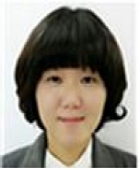
2007: Graduate School of Visual Arts, Kongju National University (Master of Engineering)
2016: Pusan University of Foreign Studies Graduate School (Doctor of Engineering - ICT Creativity Fusion)
2012–2017: IH Tech Director
2017–Present: Utobiz Co., Ltd. Director
※ Field of interest: HCI, Bigdata, ICT, Virtual Reality, Augmented Reality, Interactive, etc.

2018: Attended Computer Engineering Department, Hanbat National University
2018–Present: Utobiz Co., Ltd. Director
※ Field of interest: QT, Unity3D, Virtual Reality, Augmented Reality,
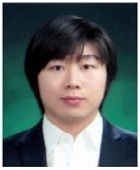
2008: Graduate School of Visual Arts, Kongju National University (Master of Engineering)
2016: Pusan University of Foreign Studies Graduate School (Doctor of Engineering - ICT Creativity Fusion)
2013–2017: Director of Research Institute, IH Tech
2017–Present: Visiting Professor at Department of Game and Multimedia, Woosong University
※ Field of interest: ICT Convergence, Stereoscopy, AR

2000: Graduate School of Tsukuba national university (Doctor of Philosophy in Intelligent Interaction Technologies)
2002–Present: Professor at Faculty of Liberal Education, Korea Nazarene university
※ Field of interest: Theology, Universal Design, AR, Big Data, Interactive, Image Processing

1997: Department of Electronics Engineering, Hannam University
2013: Department of Defense Acquisition · M&S, Hannam University School of Defense Strategy (Master of Engineering)
2018: Department of Military Science and Information, Kongju National University (Doctor of Engineering)
1998–2002: Senior Researcher, C & C, Military Mutual Aid Association
2003–2017: Director of M & D Information Technology / ARES Development Department
2017–Present: Utobiz Co., Ltd. Representative Director
※ Field of interest: Defense M & S, data linkage, war games, virtual reality, augmented reality, etc.


